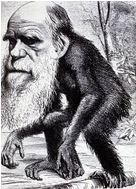 It seems as though evolutionary biology's status as a largely historical science is defended largely on the basis of a pre-established "fact" of evolution whose proof was provided essentially by Charles Darwin in 1859.
It seems as though evolutionary biology's status as a largely historical science is defended largely on the basis of a pre-established "fact" of evolution whose proof was provided essentially by Charles Darwin in 1859.Since Darwin both the tree-like pattern of inheritance (phylogenetic trees) and the proffered explanation of natural selection as a plausibly sufficient mechanism have both come into question, and yet the "fact" established by Darwin is somehow protected from question, because of the attractiveness of a unifactory principle (however decrepit) is too powerful to sway one's true belief. (Darwin said it, I believe it, that settles it!) Michael Ruse puts it this way:
There you have it. Darwin's plausible mechanism could have been essentially wrong, and the trees don't have to be real as long as one sort of tree or another might be imagined (the details are not important). Assuming a theoretical framework for speculating endlessly creative adaptational forces allows us to attribute all sorts of things to natural processes despite not knowing how the laws of the universe allow macroevolution to actually happen on its own. The important thing is that science can proceed by imagining how it might have happened. As long as the framework allows us to imagine we have a general underdetermined answer to the big questions, the fact of evolution is well established--or is established through a confluence of inferences that do not rest on either particular mechanisms or on particular genetic/familial relationships.
In dealing with the historicity argument, a great deal of confusion is brought in here by a failure to separate out certain aspects of the evolutionary endeavour. Specifically, it is always useful to distinguish between three things that evolutionists are trying to do (Ayala 1978; Ruse 1984). The first is that of establishing the fact of evolution. This, of course, is what Darwin did in the Origin of Species through his unificatory argument. Establishing that all organisms came from one or a few forms, by a natural, that is law-bound, process. Then second, one has the question of paths, or phylogenies. One is trying to trace out the actual history of life. Did the birds come from the dinosaurs or straight from other reptiles? Did humans evolve from Australopithecus afarensis, and was it the case that our ancestors got up on their hind legs and then the brain swelled up to the present size, or is the converse true? Then third, one has the question of the mechanisms or causes: what is the force behind evolutionary change?
Living species on the earth exhibit meaningful relationships to each other. This much has been understood at least since Aristotle, and Darwin was certainly not the first to try to make sense of these relationships. In fact, the taxonomies which Darwin depended on were the work of non-evolutionary thinkers. That the technological similarities of animals with similar functional designs/Bauplans go all the way down to the level of genetic programming is not a surprise to modern theorists whether they are baraminologists, Darwinists, ID theorists, or other evolutionary thinkers. The taxonomists gave us tree-thinking before Darwin. The ability of an undirected natural process to do the extraordinary sort of innovation that is required for macroevolutionary Bauplan design is an open question in evolutionary biology. Whence, then, the "fact" of macroevolution?